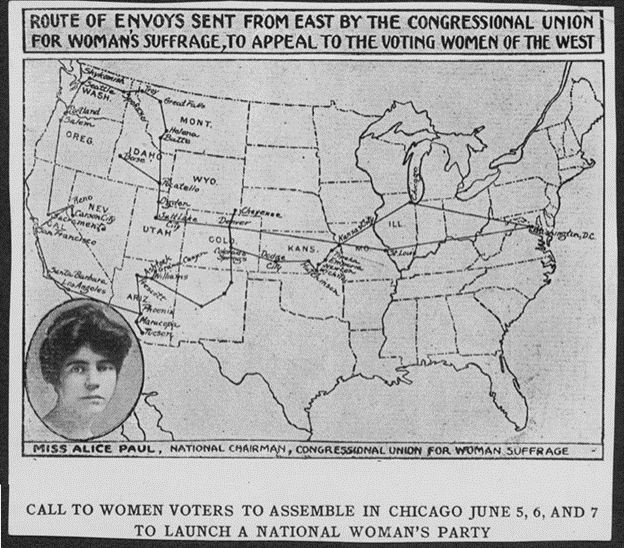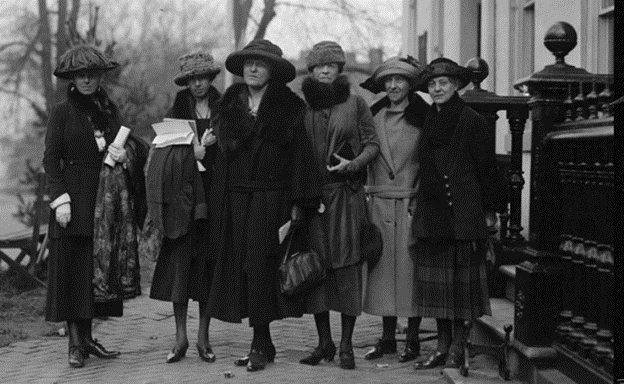Part of a series of articles titled Whose Story is History? The Diverse History of Grand Canyon.
Article
Fighting for Voting Rights at Grand Canyon and Across Arizona

LIBRARY OF CONGRESS
CU had radical and aggressive tactics, such as parades and protests, lobbing legislators, and doing speaking tours. Paul led a five-week train campaign across the West to gain support for suffrage on the federal level. On Tuesday, April 18, 1916, the group arrived in Williams, Arizona. They gave a speech to the gathered crowd on the importance of women’s voting rights nationwide. The famous suffragists then traveled to the Grand Canyon. They gathered at El Tovar Hotel in Grand Canyon Village. It was reported that, “A crowd of people from every part of the country made up their audience.” The activists utilized banners and speeches to rally the audience into support. After great success the women boarded their train. The Suffragist reported that, “The train pulled out with the purple, white and gold decorations fluttering from the windows, having carried message of unfranchised women of the east to the very rim of the canyon, a mile below sea level.” Soon after the train campaign Paul formed the National Women’s Party (NWP). One member of NWP who was very familiar with Grand Canyon was Mary Dean Powell.

LIBRARY OF CONGRESS
While this was a monumental achievement for women across the country, this success truly only applied to White women. While Black women were technically allowed to vote after the passage of the 19th Amendment, it would not be until the Voting Rights Act of 1965 when these rights would be protected. This same Voting Rights Act would help to ensure the rights of other communities as well, including Native Americans.
The Snyder Act of 1924 gave Indigenous people United States citizenship. This did not guarantee voting rights, since ultimately states made that choice. In 1928, Peter Porter and Rudolph Johnson of the Gila River Indian Community went to register to vote in Pinal County, Arizona. They were denied the right to vote by the county. In order to fight this discrimination, they filled a lawsuit in a case called Porter v. Hall, but their case was overturned. The court used a highly offensive article from the Constitution of Arizona. The article stated that Indigenous people were “persons under guardianship” and therefore were ineligible to vote. After The Nationality Act of 1940 and after many Native Americans enlisted in WWII, the argument against allowing Indigenous people the right to vote became weak.
Two members of the Yavapai Nation--Frank Harrison, a WWII veteran, and Harry Austin, the chairman of the tribe--challenged this outdated exclusion. When they registered to vote, they were turned away. Harrison and Austin filed a lawsuit and won their case in the Arizona Supreme Court. In 1948, the Supreme Court overturned Porter v. Hall. Even with these victories, the same restrictions set against Black voters, such as literacy tests, were utilized against Indigenous people in a similar way. The 1965 Voting Rights Act would impact the voting rights of Indigenous communities as well. However, this did not end the challenges of voting rights for people living on reservations. Insufficient polling locations, lack of translations into tribal languages, and other challenges on rural communities still create obstacles for Indigenous communities to participate in the political process.
Sources:
Stafford, Cindy. "Suff’s Campaign Gains Steam at El Tovar." The Ol’ Pioneer 31, no. 4 (2020): 3-5. https://grandcanyonhistory.org/uploads/3/4/4/2/34422134/op_v_31_no_4_fall_2020.pdf.
Stafford, Cindy. "Mary Dean Powell at Grand Canyon: No Room at the Inn?" The Ol’ Pioneer 31, no. 3 (2020): 4-7. https://grandcanyonhistory.org/uploads/3/4/4/2/34422134/op_v_31_no_3_summer_2020.pdf.
Rollings, Willard Hughes. "Citizenship and Suffrage: The Native American Struggle for Civil Rights in the American West, 1830-1965." Nevada Law Journal 5, no. 1 (2004): 126-140. https://scholars.law.unlv.edu/cgi/viewcontent.cgi?article=1311&context=nlj.
Ferguson-Bohnee, Patty. "The History of Indian Voting Rights in Arizona: Overcoming Decades of Voter Suppression." Arizona State Law Journal 47 (2015): 1099-1144. https://arizonastatelawjournal.org/wp-content/uploads/2016/02/Ferguson_Final.pdf.
Last updated: October 16, 2024
